Complete Solutions to Exercise(Linked Comprehension ) of chapter ELECTROCHEMISTRY of Class 12 book with complete answers and questions
| Class 12 | CHEMISTRY |
| Chapter | ELECTROCHEMISTRY |
| CENGAGE CHEMISTRY | Exercise(Linked Comprehension ) |
| Number Of Questions | 30 |
| Academic Year | 2023-24 |
An aqueous solution containing `0.1M Fe^(3+)` and `0.01 M Fe^(2+)` was titrated with a concentrated solution of `NaOH` at `30^(@)C` , so that changes in volumes were negligible. Assuming that the new species formed during titration are `Fe(OH)_(3)` and `Fe(OH)_(2)` only.
Given `E^(c-)._(Fe^(3+)|Fe^(2+))=0.80V, `
`K_(spFe(OH)_(3))=10^(-37), ` and `K_(sp Fe(OH)_(2))=10^(-19)`
The redox potential of `Fe^(3+)|Fe^(2+)` electrode at `pH=6` is04:56View SolutionAn aqueous solution containing `0.1M Fe^(3+)` and `0.01 M Fe^(2+)` was titrated with a concentrated solution of `NaOH` at `30^(@)C` , so that changes in volumes were negligible. Assuming that the new species formed during titration are `Fe(OH)_(3)` and `Fe(OH)_(2)` only.
Given `E^(c-)._(Fe^(3+)|Fe^(2+))=0.80V, `
`K_(spFe(OH)_(3))=10^(-37), ` and `K_(sp Fe(OH)_(2))=10^(-19)`
The redox potential of `Fe^(3+)|Fe^(2+)` electrode at `pH=6` is04:56View SolutionAn aqueous solution containing `0.1M Fe^(3+)` and `0.01 M Fe^(2+)` was titrated with a concentrated solution of `NaOH` at `30^(@)C` , so that changes in volumes were negligible. Assuming that the new species formed during titration are `Fe(OH)_(3)` and `Fe(OH)_(2)` only.
Given `E^(c-)._(Fe^(3+)|Fe^(2+))=0.80V, `
`K_(spFe(OH)_(3))=10^(-37), ` and `K_(sp Fe(OH)_(2))=10^(-19)`
The redox potential of `Fe^(3+)|Fe^(2+)` electrode at `pH=6` is04:56View SolutionCalculate `Delta_(r)G^(c-)` of the reaction `:`
`Ag^(o+)(aq)+Cl^(c-)(aq) rarr AgCl(s)`
Given `:Delta_(f)G^(c-)._(AgCl)=-109kJ mol ^(-1)`
`Delta_(f)G^(c-)_((Cl^(c-)))=-129k J mol ^(-1)`
`Delta_(f)G^(c-)._((Ag^(o+)))=-77 kJ mol ^(-1)`11:54View Solution`E^(c-)._(cell)` of the reaction above in Question is
11:54View Solution`K_(sp)` of `AgCl` is
11:54View Solution`6.537 xx 10^(-2)f ` of metallic `Zn` was added to `100 mL` of saturated solution of `AgCl` . Calculate `log .([Zn^(2+)])/([Ag^(o+)])`.
Given `: E^(c-)._(Ag^(o+)|Ag)=0.80V, E^(c-)._(Zn^(2+)|Zn)=-0.763V`.
`K_(sp)` of `AgCl~~10^(-10),` atomic weight of `Zn=65.37`11:54View SolutionCalculate the number of moless of `Ag` formed above in Question.
11:54View SolutionThe magnitude `(` but not the sign `)` of the standard reduction potentials of two metals `X` and `Y` are `:`
`Y^(2)+2e^(-) rarr Y |E_(1)^(c-)|=0.34V`
`X^(2)+2e^(-) rarr X |E_(2)^(c-)|=0.25V`
When the two half cells of `X` and `Y `are connected to construct a cell, eletrons flow from `X` to `Y`. When `X` is connected to a standard hydrogen electrode `(SHE)`,electrons flow from `X` to `SHE`.
If a half call `X|X^(2)(0.1M)` is connected to another half cell `Y|Y^(2+)(1.0M)` by means of a salt bridge and an external circuit at `25^(@)C`, the cell voltage would be12:19View SolutionThe magnitude `(` but not the sign `)` of the standard reduction potentials of two metals `X` and `Y` are `:`
`Y^(2)+2e^(-) rarr Y |E_(1)^(c-)|=0.34V`
`X^(2)+2e^(-) rarr X |E_(2)^(c-)|=0.25V`
When the two half cells of `X` and `Y `are connected to construct a cell, eletrons flow from `X` to `Y`. When `X` is connected to a standard hydrogen electrode `(SHE)`,electrons flow from `X` to `SHE`.
If standard emf `(E^(c-))` of a half cell `Y^(2)|Y^(o+)` is `0.15V`, the standard emf of the half cell `Y^(o+)|Y` will be12:19View SolutionThe magnitude `(` but not the sign `)` of the standard reduction potentials of two metals `X` and `Y` are `:`
`Y^(2)+2e^(-) rarr Y |E_(1)^(c-)|=0.34V`
`X^(2)+2e^(-) rarr X |E_(2)^(c-)|=0.25V`
When the two half cells of `X` and `Y `are connected to construct a cell, eletrons flow from `X` to `Y`. When `X` is connected to a standard hydrogen electrode `(SHE)`,electrons flow from `X` to `SHE`.
Given the following half cell `: YI+e^(-) rarr Y-I^(c-): " "E^(c-)=-0.27 V`
Solubility product of the iodide salt `YI` is12:19View SolutionA volataic cell consists of an electode of solide silver immerse in a `0.10M AgNO_(3)` solution and an electrode of unknown metal `'X'` immersed in a `0.10M` solution `X(NO_(3))_(2)`. A porous barrier separates the two half of the cell. Also given `:`
`E^(c-)._((Ag^(o+)|Ag))=0.80V` and `E^(c-)._(cell)=1.05V` at `25^(@)C`
`X(s)|X^(2+)(1.0M)||Ag^(o+)(0.1M)|Ag(s)`
Which of the following statements regarding the cell and `X` is incorrect?07:26View SolutionA volataic cell consists of an electode of solide silver immerse in a `0.10M AgNO_(3)` solution and an electrode of unknown metal `'X'` immersed in a `0.10M` solution `X(NO_(3))_(2)`. A porous barrier separates the two half of the cell. Also given `:`
`E^(c-)._((Ag^(o+)|Ag))=0.80V` and `E^(c-)._(cell)=1.05V` at `25^(@)C`
`X(s)|X^(2+)(1.0M)||Ag^(o+)(0.1M)|Ag(s)`
If `Ag^(o+)|Ag` half cell in the above voltaic cell is replaced by `Zn^(2+)|Zn` half cell `(E^(c-)._(Zn^(2+)|Zn)=-0.76V)`07:26View SolutionFuel cells `:` Fuel cells are galvanic cells in which the chemical energy of fuel cell is directly converted into electrical energy. A type of fuel cell is a hydrogen `-` oxygen fuel cell. It consists of two electrodes made up of two porous graphite impregnated with a catalyst `(` platinum, silver, or metal oxide `).` The electrodes are placed in aqueous solution of `NaOH` . Oxygen and hydrogen are continuously fed into the cell. Hydrogen gets oxidized to `H^(o+)` which is neutralized by `overset(c-)(O)H, i.e.,` anodic reaction.
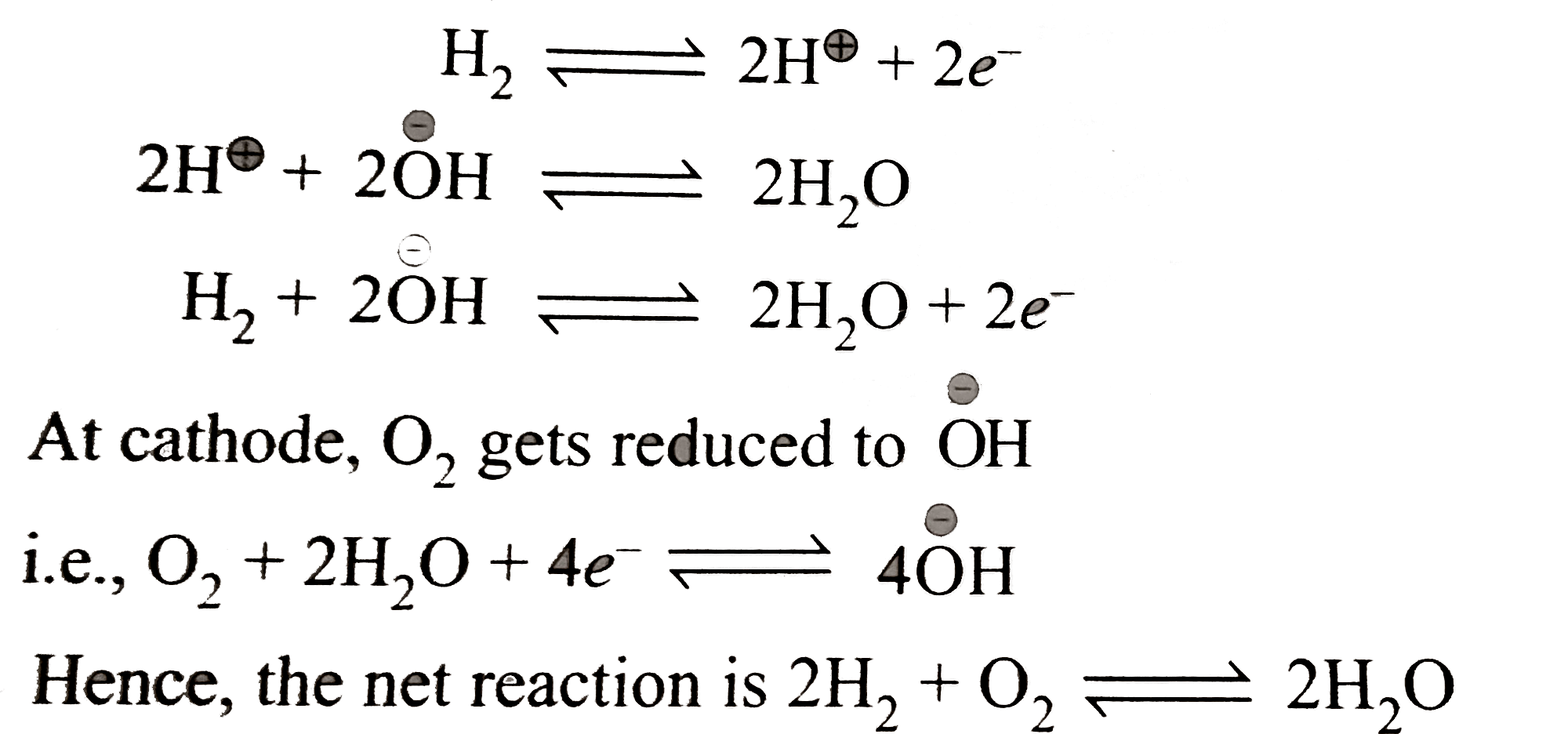
At cathode, `O_(2)` gets reduced to `overset(c-)(O)H`

Hence, the net reaction is
The overall reaction has
`DeltaH=-285.6 kJ mol^(-1)` and `DeltaG=-237.4 kJ mol^(-1)` at `25^(@)C`
If the cell voltage is `1.23V` for the `H_(2)-O_(2)` fuel cell and for the half cell `:`08:04View SolutionFuel cells `:` Fuel cells are galvanic cells in which the chemical energy of fuel cell is directly converted into electrical energy. A type of fuel cell is a hydrogen `-` oxygen fuel cell. It consists of two electrodes made up of two porous graphite impregnated with a catalyst `(` platinum, silver, or metal oxide `).` The electrodes are placed in aqueous solution of `NaOH` . Oxygen and hydrogen are continuously fed into the cell. Hydrogen gets oxidized to `H^(o+)` which is neutralized by `overset(c-)(O)H, i.e.,` anodic reaction.
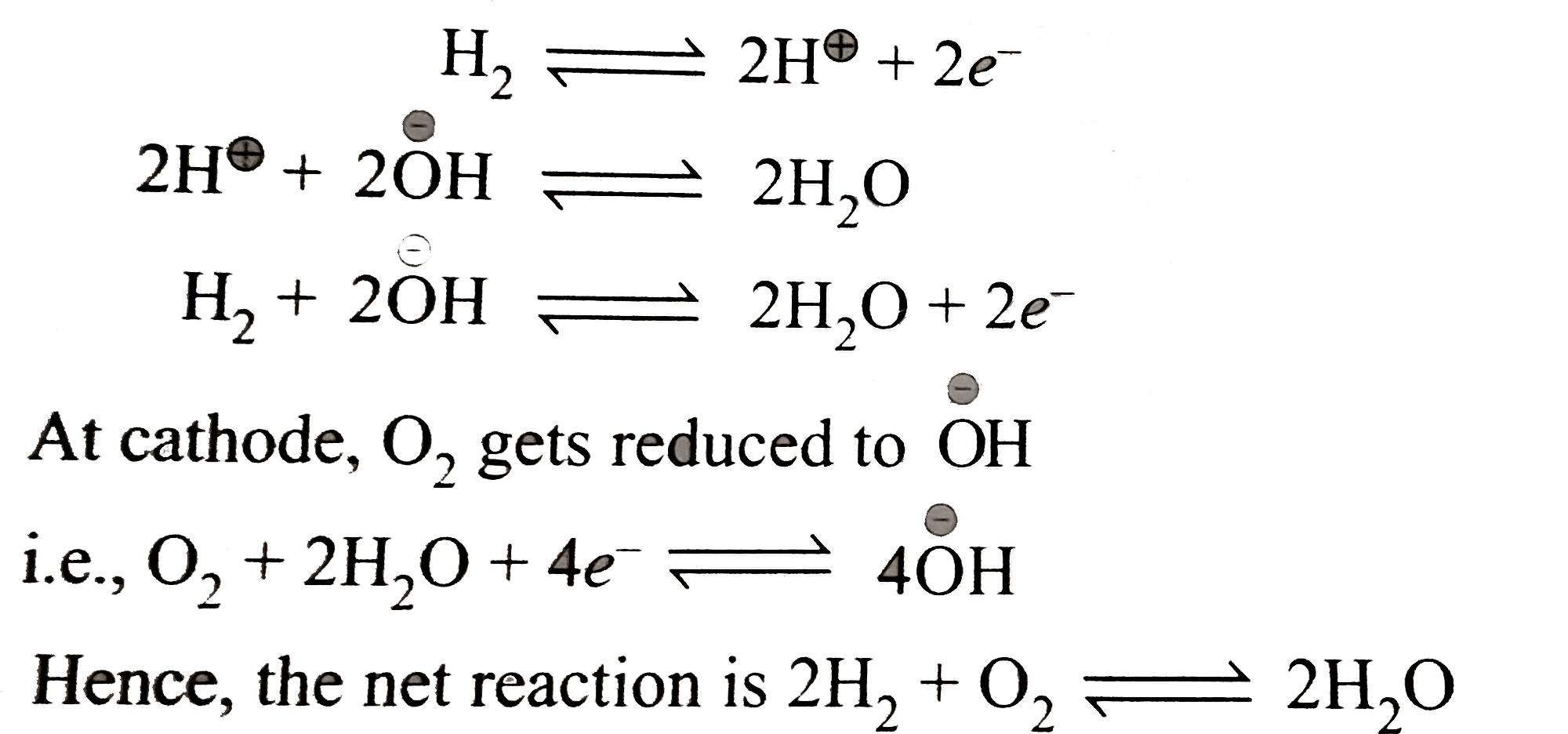
At cathode, `O_(2)` gets reduced to `overset(c-)(O)H`
Hence, the net reaction is
The overall reaction has
`DeltaH=-285.6 kJ mol^(-1)` and `DeltaG=-237.4 kJ mol^(-1)` at `25^(@)C`
What is the value of `DeltaS^(c-)` for the fuel cell at `25^(@)C`?08:04View SolutionFuel cells `:` Fuel cells are galvanic cells in which the chemical energy of fuel cell is directly converted into electrical energy. A type of fuel cell is a hydrogen `-` oxygen fuel cell. It consists of two electrodes made up of two porous graphite impregnated with a catalyst `(` platinum, silver, or metal oxide `).` The electrodes are placed in aqueous solution of `NaOH` . Oxygen and hydrogen are continuously fed into the cell. Hydrogen gets oxidized to `H^(o+)` which is neutralized by `overset(c-)(O)H, i.e.,` anodic reaction.
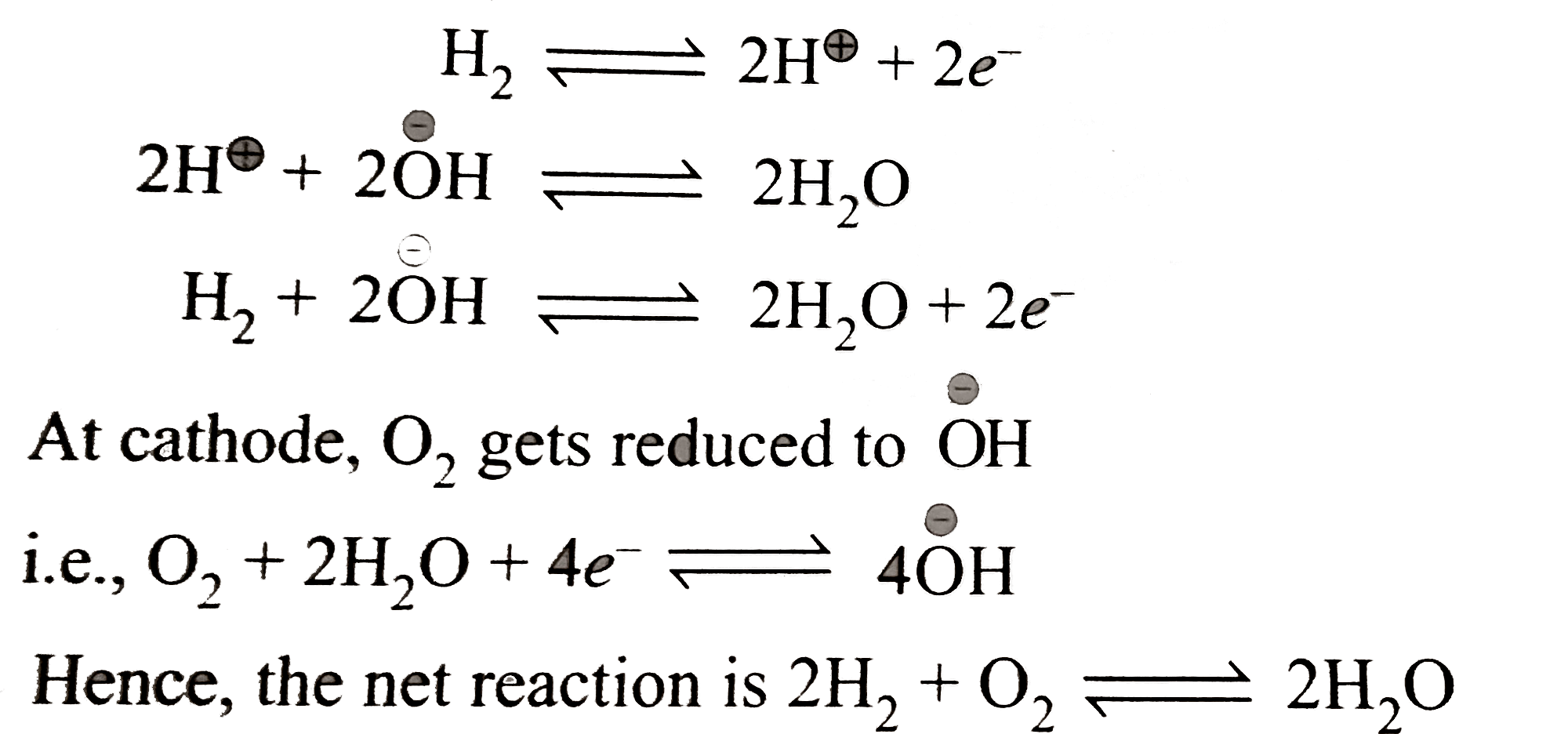
At cathode, `O_(2)` gets reduced to `overset(c-)(O)H`
Hence, the net reaction is
The overall reaction has
`DeltaH=-285.6 kJ mol^(-1)` and `DeltaG=-237.4 kJ mol^(-1)` at `25^(@)C`
Suppose the concentration of hydroxide ioin in the cell is doubled, then the cell voltage will be08:04View SolutionFuel cells `:` Fuel cells are galvanic cells in which the chemical energy of fuel cell is directly converted into electrical energy. A type of fuel cell is a hydrogen `-` oxygen fuel cell. It consists of two electrodes made up of two porous graphite impregnated with a catalyst `(` platinum, silver, or metal oxide `).` The electrodes are placed in aqueous solution of `NaOH` . Oxygen and hydrogen are continuously fed into the cell. Hydrogen gets oxidized to `H^(o+)` which is neutralized by `overset(c-)(O)H, i.e.,` anodic reaction.
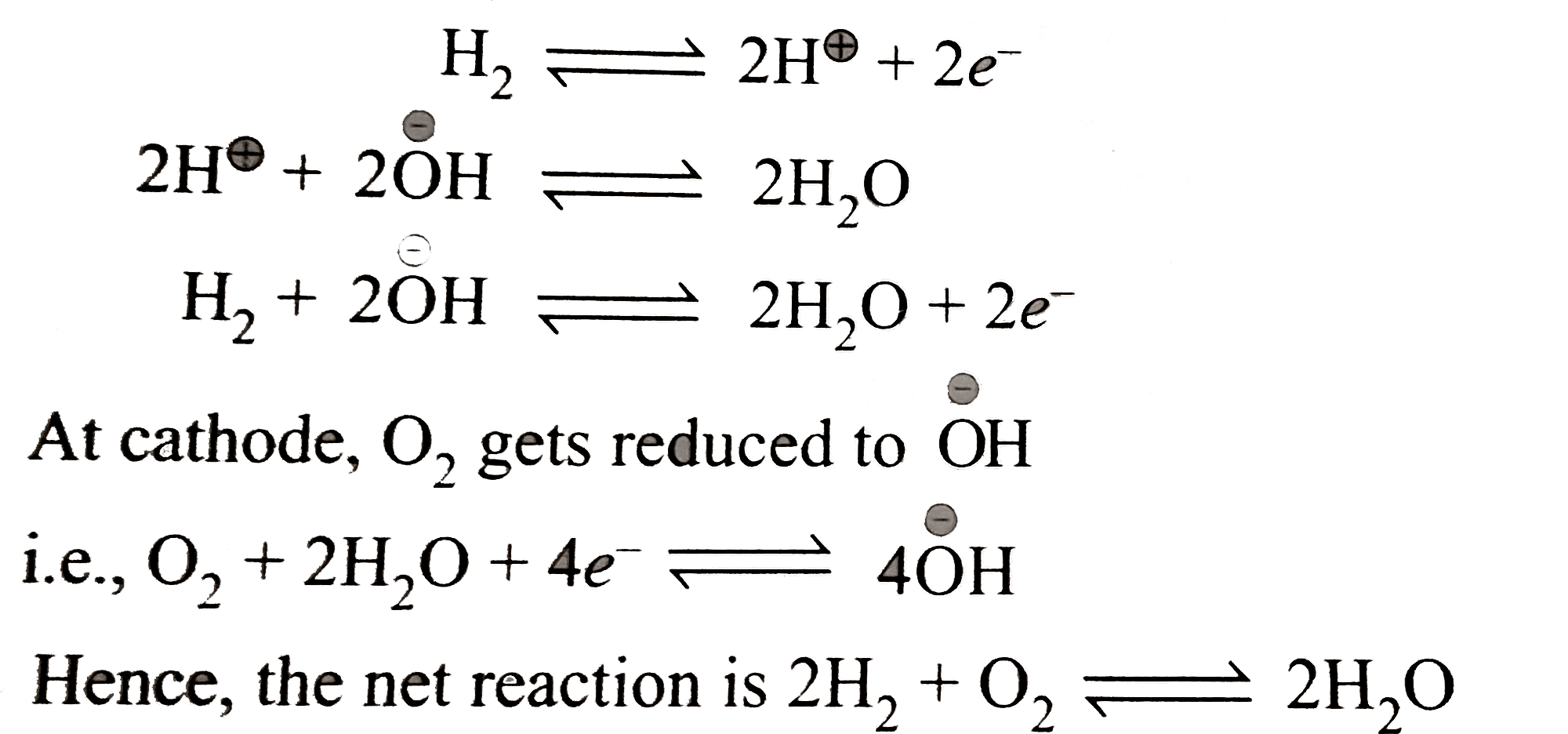
At cathode, `O_(2)` gets reduced to `overset(c-)(O)H`
Hence, the net reaction is
The overall reaction has
`DeltaH=-285.6 kJ mol^(-1)` and `DeltaG=-237.4 kJ mol^(-1)` at `25^(@)C`
A fuel cell is
`I.` A voltaic cell in which continuous supply of fuels are sent at anode to perform oxidation.
`II.` A voltaci cell in which fuels such as `:CH_(4),H_(2),` and `CO` are used up at anode.
`III.` One which involves the reaction of `H_(2)-O_(2)` fuel cell such as `:`
Anode `:2H_(2)O+4overset(c-)(O)H rarr 4H_(2)O(l)+4e^(c-)`
Cathode `: O_(2)+2H_(2)O(l) =4e^(-) rarr 4overset(c-)(O)H`
`IV.` The efficiency of `H_(2)-O_(20` fuel cell is 70 to `75%`08:04View SolutionA conductivity cell is used to measure the conductance of electrolyte . It makes use of conductivity of water which does not contain any ions. The cell constant of conductivity cell is determined.
If the cell constant is `0.40 cm^(-1)`, the conductivity of `0.051 M NaCl` solution having `R=1850 ohm` is equal to03:37View SolutionA conductivity cell is used to measure the conductance of electrolyte . It makes use of conductivity of water which does not contain any ions. The cell constant of conductivity cell is determined.
Calculate `alpha` of `CH_(3)COOH` if `Delta^(oo)._(m)` for `HCl, NaCl, CH_(3)COOHNa` are `426,126,91 S cm^(2) mol^(-1)`, respectively, and `wedge_(m)=14.4 S cm^(2) mol^(-1) ` at `0.015 M` concentration.03:37View SolutionBreathalyzer is used to detect the alcohol content in the suspected drunk drivers. The ethanol in the exhaled breath is oxidized to ethanoic acid with an acidic solution of `K_(2)Cr_(2)O_(7)` as follows `:`
`underset(Ehanol)(3CH_(3)CH_(2)OH(aq))+2Cr_(2)O_(7)^(2-)(aq) +16H^(o+)(aq) rarr underset(Ethanoic ac i d)(3CH_(3)COH(aq))+4Cr^(3+)(aq)+11H_(2)O(l)`
The breathalyzer measures the colour change and produces a metre reading calibrated in the terms of blood alcohol content.
If `E^(c-)._(CH_(3)COOH|C_(2)H_(5)OH)=0.06 V` and `E^(c-)._(Cr_(2)O_(7)^(2-)|Cr^(3+))=1.33V`,
then `E^(c-)._(cell)` of the reaction taking place in alcohol metre is08:48View SolutionBreathalyzer is used to detect the alcohol content in the suspected drunk drivers. The ethanol in the exhaled breath is oxidized to ethanoic acid with an acidic solution of `K_(2)Cr_(2)O_(7)` as follows `:`
`underset(Ehanol)(3CH_(3)CH_(2)OH(aq))+2Cr_(2)O_(7)^(2-)(aq) +16H^(o+)(aq) rarr underset(Ethanoic ac i d)(3CH_(3)COH(aq))+4Cr^(3+)(aq)+11H_(2)O(l)`
The breathalyzer measures the colour change and produces a metre reading calibrated in the terms of blood alcohol content.
Colour of the testing solution changes from08:48View SolutionBreathalyzer is used to detect the alcohol content in the suspected drunk drivers. The ethanol in the exhaled breath is oxidized to ethanoic acid with an acidic solution of `K_(2)Cr_(2)O_(7)` as follows `:`
`underset(Ehanol)(3CH_(3)CH_(2)OH(aq))+2Cr_(2)O_(7)^(2-)(aq) +16H^(o+)(aq) rarr underset(Ethanoic ac i d)(3CH_(3)COH(aq))+4Cr^(3+)(aq)+11H_(2)O(l)`
The breathalyzer measures the colour change and produces a metre reading calibrated in the terms of blood alcohol content.
The `EMF` of the reaction when the concentration of all the species are `1.0M` and `pH` is `4.0` is08:48View SolutionBreathalyzer is used to detect the alcohol content in the suspected drunk drivers. The ethanol in the exhaled breath is oxidized to ethanoic acid with an acidic solution of `K_(2)Cr_(2)O_(7)` as follows `:`
`underset(Ehanol)(3CH_(3)CH_(2)OH(aq))+2Cr_(2)O_(7)^(2-)(aq) +16H^(o+)(aq) rarr underset(Ethanoic ac i d)(3CH_(3)COH(aq))+4Cr^(3+)(aq)+11H_(2)O(l)`
The breathalyzer measures the colour change and produces a metre reading calibrated in the terms of blood alcohol content.
What is the ethanol ethanoic acid ratio if the breathalyzer records `1.33V` and other species are at `1M ?`08:48View SolutionA cell, as shown below, consists of there compartments separated by porous pots. The first contains a cobalt eletrode in `5.0L` of `0.10M Co(NO_(3)),` the second contains `5.0L` of `0.10M KNO_(3),` the third contains an `Ag` electrode in `5.0L` of `0.10M AgNO_(3)`. Assuming that current with in the cell iis carried equally by the negative and positive ions by passign `0.1F` of electricity.

Given `: Co^(2+)+2e^(-) rarr Co" "E^(c-)=-0.28V`
Ag^(o+)+e^(-) rarr Ag" "E^(c-)=0.80V`
`2Ag^(o+)+Corarr Co^(2+)+2Ag" "E^(c-)._(cell)=1.08V`
Finally, the `I` compartment contains
`I. Co^(2+)" "II. NO_(3)^(c-)" "III.K^(o+)" "IV.Ag^(o+)`20:32View SolutionA cell, as shown below, consists of there compartments separated by porous pots. The first contains a cobalt eletrode in `5.0L` of `0.10M Co(NO_(3)),` the second contains `5.0L` of `0.10M KNO_(3),` the third contains an `Ag` electrode in `5.0L` of `0.10M AgNO_(3)`. Assuming that current with in the cell iis carried equally by the negative and positive ions by passign `0.1F` of electricity.
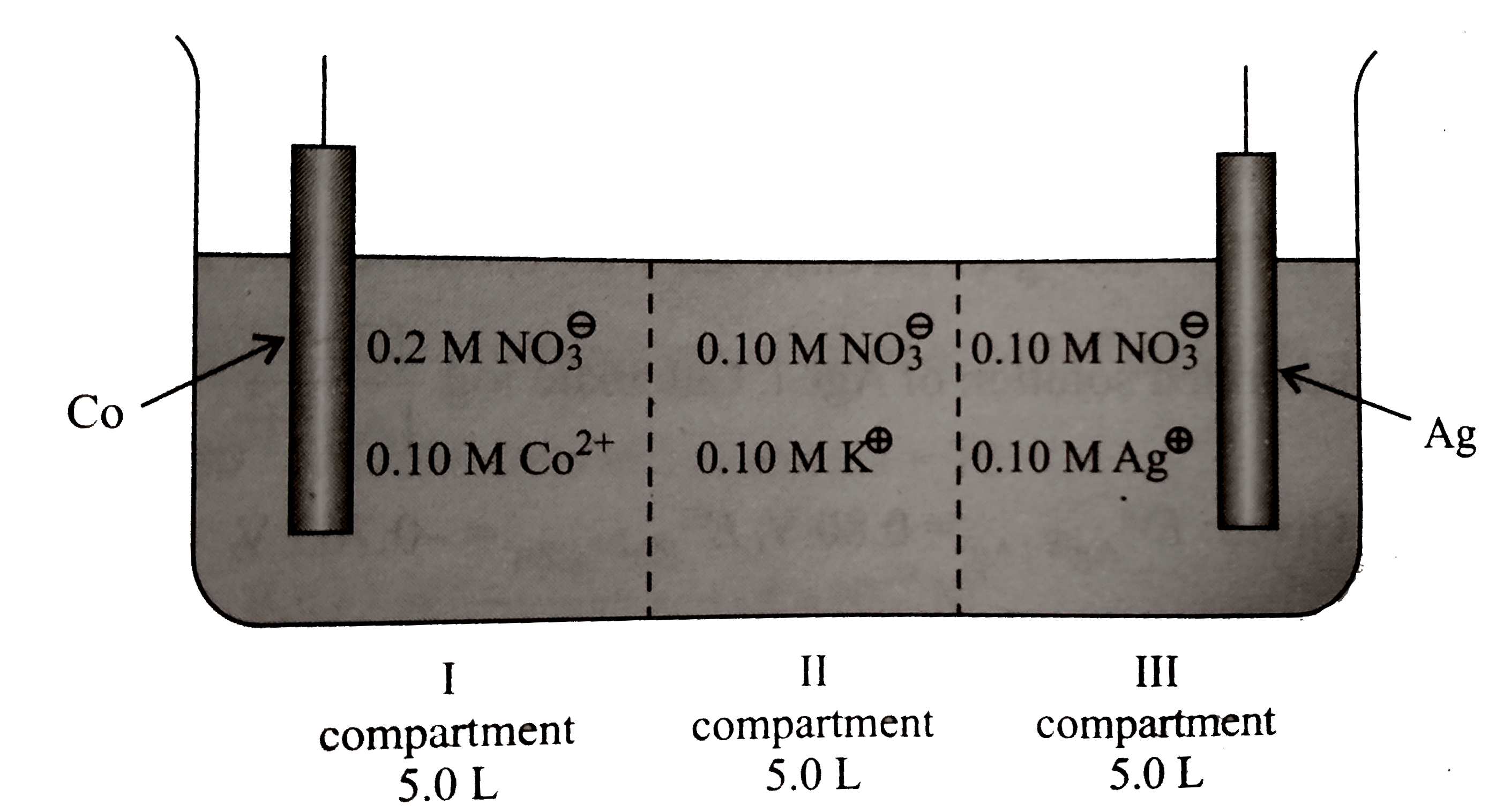
Given `: Co^(2+)+2e^(-) rarr Co" "E^(c-)=-0.28V`
Ag^(o+)+e^(-) rarr Ag" "E^(c-)=0.80V`
`2Ag^(o+)+Corarr Co^(2+)+2Ag" "E^(c-)._(cell)=1.08V`
Finally, the `II` compartment contains20:32View SolutionA cell, as shown below, consists of there compartments separated by porous pots. The first contains a cobalt eletrode in `5.0L` of `0.10M Co(NO_(3)),` the second contains `5.0L` of `0.10M KNO_(3),` the third contains an `Ag` electrode in `5.0L` of `0.10M AgNO_(3)`. Assuming that current with in the cell iis carried equally by the negative and positive ions by passign `0.1F` of electricity.
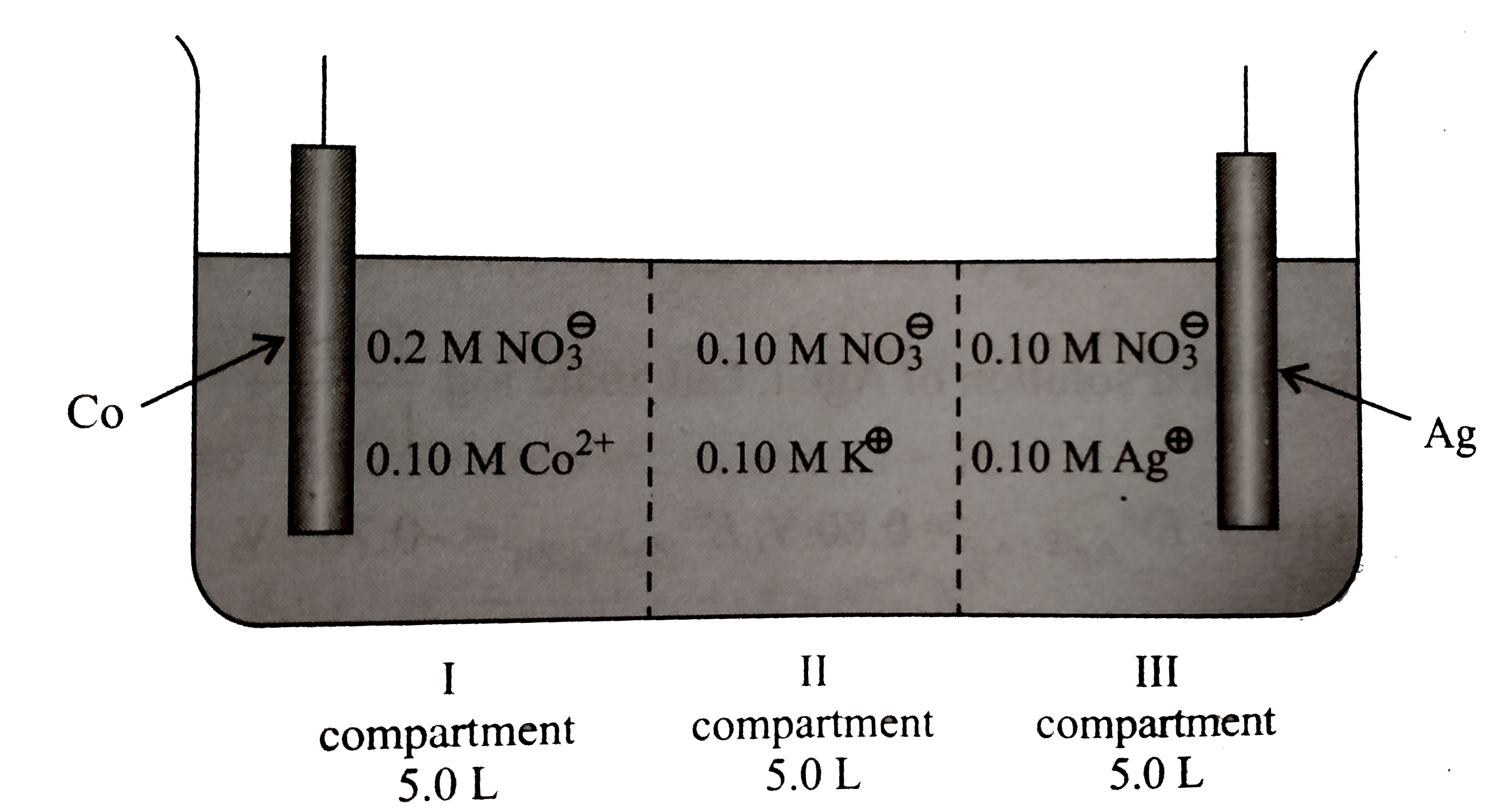
Given `: Co^(2+)+2e^(-) rarr Co" "E^(c-)=-0.28V`
Ag^(o+)+e^(-) rarr Ag" "E^(c-)=0.80V`
`2Ag^(o+)+Corarr Co^(2+)+2Ag" "E^(c-)._(cell)=1.08V`
Finally the `II` compartment contains20:32View SolutionA cell, as shown below, consists of there compartments separated by porous pots. The first contains a cobalt eletrode in `5.0L` of `0.10M Co(NO_(3)),` the second contains `5.0L` of `0.10M KNO_(3),` the third contains an `Ag` electrode in `5.0L` of `0.10M AgNO_(3)`. Assuming that current with in the cell iis carried equally by the negative and positive ions by passign `0.1F` of electricity.
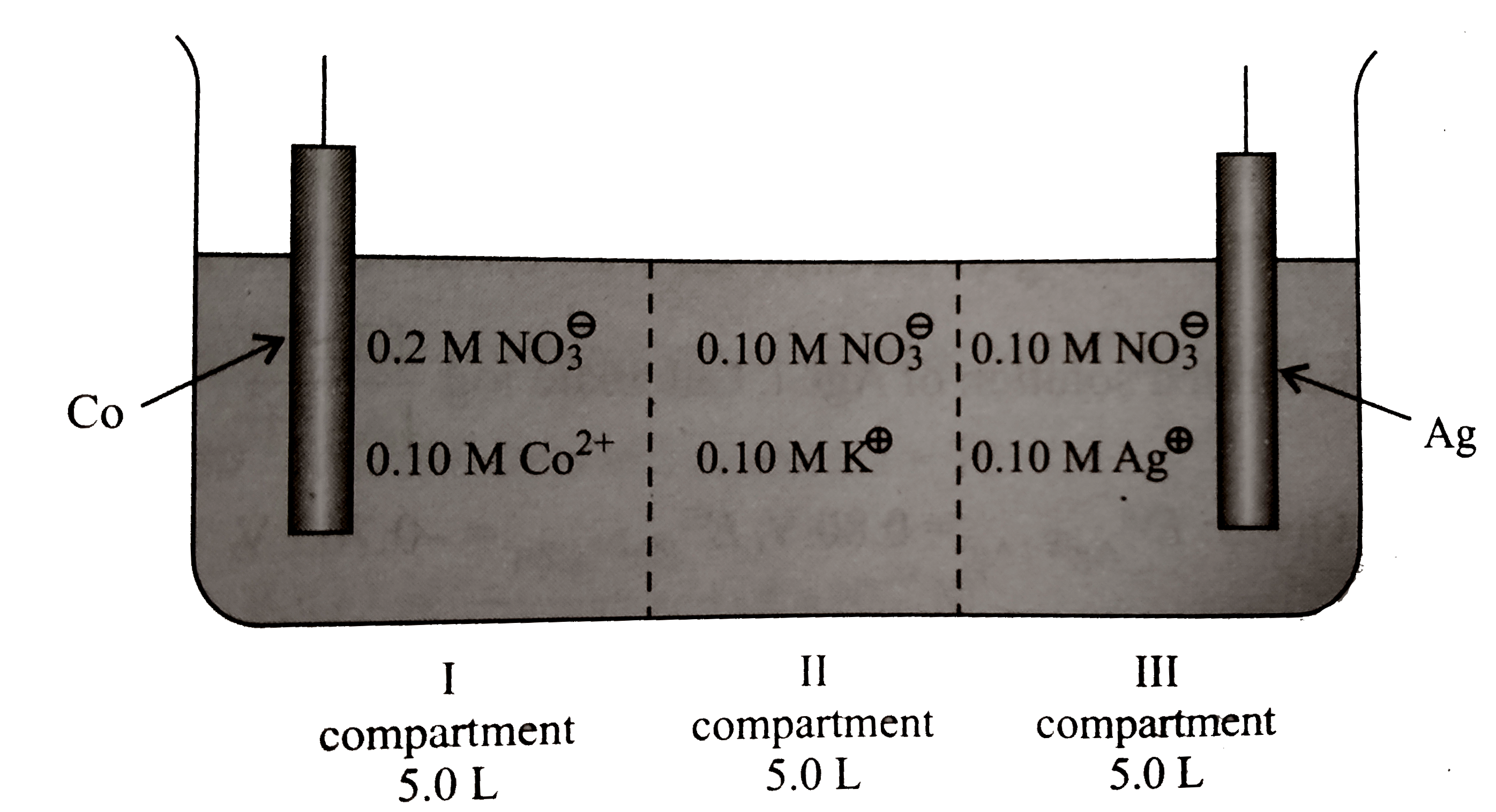
Given `: Co^(2+)+2e^(-) rarr Co" "E^(c-)=-0.28V`
Ag^(o+)+e^(-) rarr Ag" "E^(c-)=0.80V`
`2Ag^(o+)+Corarr Co^(2+)+2Ag" "E^(c-)._(cell)=1.08V`
The final concentration of `Co^(2+)` in `I, II, `and `III` compartment is20:32View SolutionA cell, as shown below, consists of there compartments separated by porous pots. The first contains a cobalt eletrode in `5.0L` of `0.10M Co(NO_(3)),` the second contains `5.0L` of `0.10M KNO_(3),` the third contains an `Ag` electrode in `5.0L` of `0.10M AgNO_(3)`. Assuming that current with in the cell iis carried equally by the negative and positive ions by passign `0.1F` of electricity.
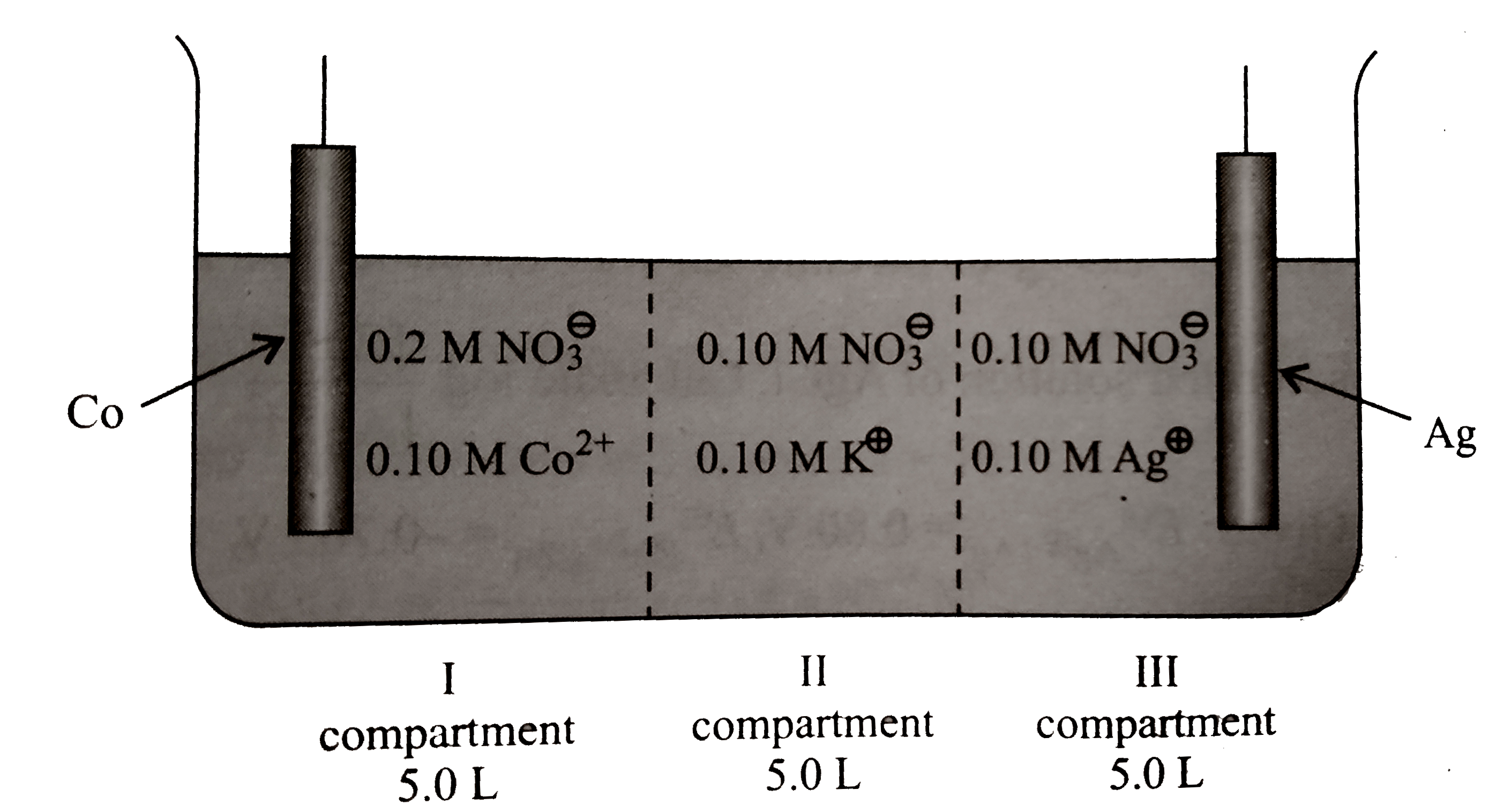
Given `: Co^(2+)+2e^(-) rarr Co" "E^(c-)=-0.28V`
Ag^(o+)+e^(-) rarr Ag" "E^(c-)=0.80V`
`2Ag^(o+)+Corarr Co^(2+)+2Ag" "E^(c-)._(cell)=1.08V`
The final concentration of `NO_(3)^(c-)` in `I,II,` and `III` compartment is20:32View SolutionA cell, as shown below, consists of there compartments separated by porous pots. The first contains a cobalt eletrode in `5.0L` of `0.10M Co(NO_(3)),` the second contains `5.0L` of `0.10M KNO_(3),` the third contains an `Ag` electrode in `5.0L` of `0.10M AgNO_(3)`. Assuming that current with in the cell iis carried equally by the negative and positive ions by passign `0.1F` of electricity.
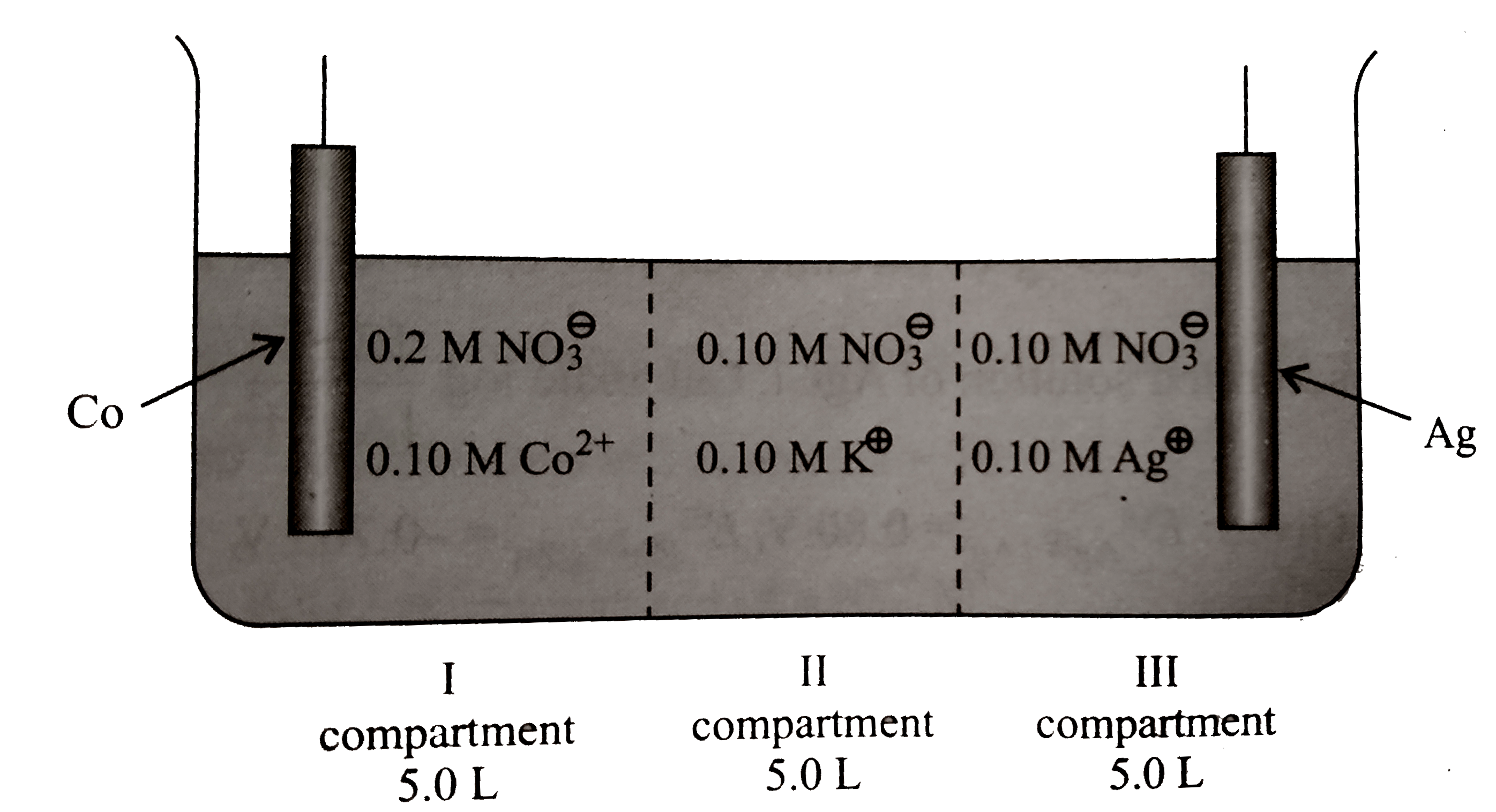
Given `: Co^(2+)+2e^(-) rarr Co" "E^(c-)=-0.28V`
Ag^(o+)+e^(-) rarr Ag" "E^(c-)=0.80V`
`2Ag^(o+)+Corarr Co^(2+)+2Ag" "E^(c-)._(cell)=1.08V`
The final concentration of `K^(o+)` in `I,II, `and `III` compartment is20:32View SolutionA cell, as shown below, consists of there compartments separated by porous pots. The first contains a cobalt eletrode in `5.0L` of `0.10M Co(NO_(3)),` the second contains `5.0L` of `0.10M KNO_(3),` the third contains an `Ag` electrode in `5.0L` of `0.10M AgNO_(3)`. Assuming that current with in the cell iis carried equally by the negative and positive ions by passign `0.1F` of electricity.
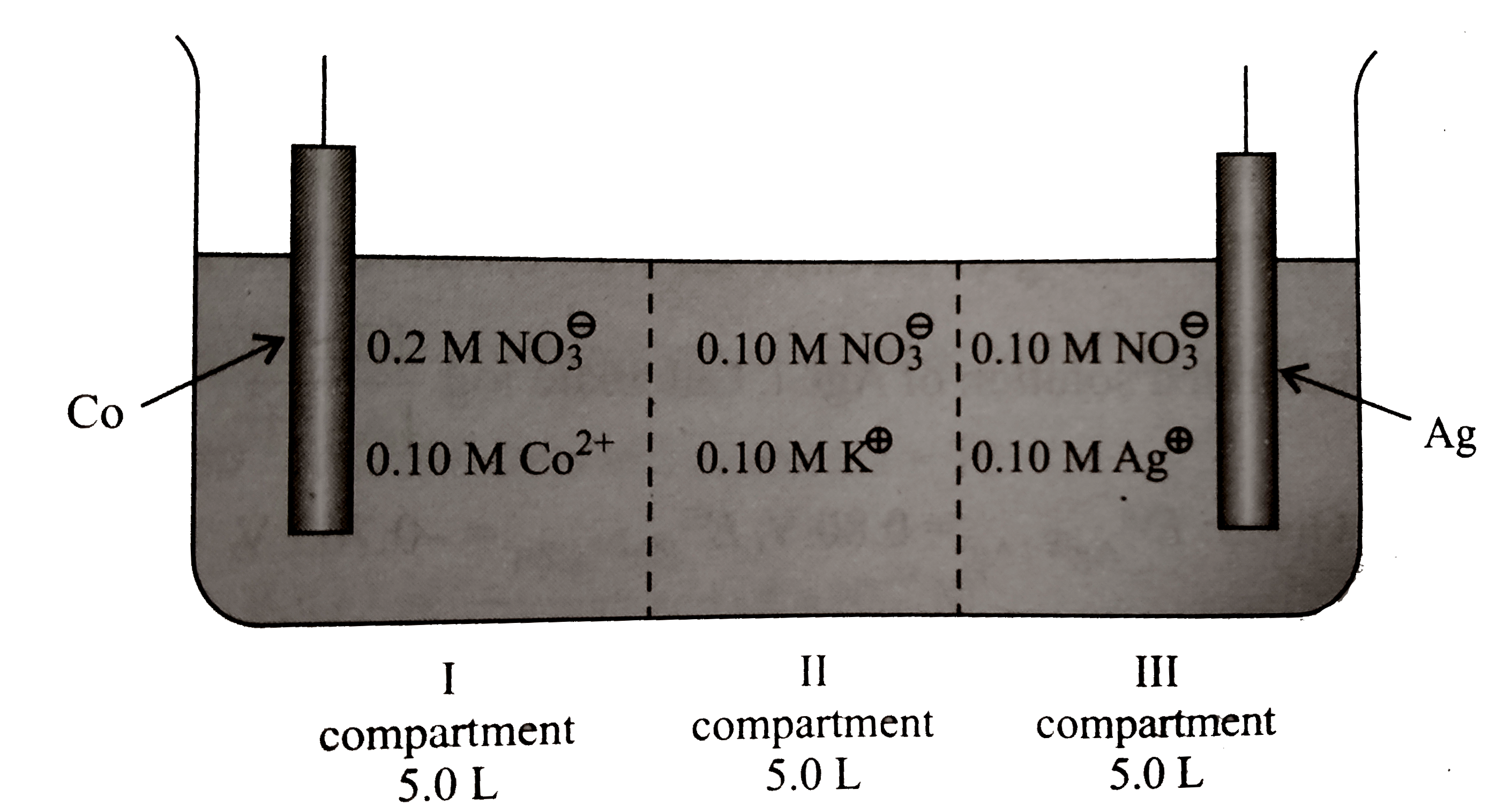
Given `: Co^(2+)+2e^(-) rarr Co" "E^(c-)=-0.28V`
Ag^(o+)+e^(-) rarr Ag" "E^(c-)=0.80V`
`2Ag^(o+)+Corarr Co^(2+)+2Ag" "E^(c-)._(cell)=1.08V`The final concentration of `Ag^(o+)` in `I,II,` and `III` compartment is20:32View Solution
Exercise(Linked Comprehension ) questions and complete solutions for chapter ELECTROCHEMISTRY of CENGAGE CHEMISTRY (HINGLISH) of Class 12
All Exercises from CENGAGE CHEMISTRY Class 12 CHEMISTRY ELECTROCHEMISTRY
- Archieves (Linked Comprehension )
- Archieves Fill In The Blanks
- Archieves Multiple Correct Ansers
- Archieves Single Correct
- Archieves Subjective
- Archieves True/False
- Ex 3.1 (Objective)
- Ex 3.2 (Objective)
- Ex 3.3 (Objective)
- Exercise(Linked Comprehension )
- Exerciseassertion -Reasoning
- Exercisefill In The Blanks
- Exerciseinterger
- Exercisemultiple Correct Ansers
- Exercises Ingle Correct
- Exercisetrue / False
- Illustration
- Solved Examples (Electrochemical Cell)
- Solved Examples(Electrolysis And Electrolytic Cells)
